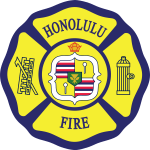Inspections
Honolulu Fire Department is required to inspect all buildings, premises, and public thoroughfares, except interiors of private dwellings and state-owned airport facilities.
Preparing for a Fire Code Inspection
A fire inspection of your property or business by the Honolulu Fire Department shall include the building’s common areas and each business owners’ occupancy. Alternate arrangements shall be made if owners are unable to meet or availability is limited during the scheduled inspection.
The Fire Inspector must have access to requested areas during the walk through inspection and must be accompanied by each owner or his/her representative. Keys must be made available for locked spaces. Business owners are encouraged to notify their employees of the inspection, and every effort should be made to facilitate a thorough inspection. The inspection will take approximately 20 minutes per business owner and conclude when the Fire Inspector issues a Fire Inspection Report.
Corrective action for fire code violations shall be initiated immediately. The Fire Inspector will schedule a re-inspection with the owner two weeks after the date of the initial inspection. A Notice of Violation will be issued for corrections not made within the two-week time period.
Business owners are encouraged to examine their premises prior to the inspection. Specific questions may be directed to the Fire Inspector during the inspection. Owners are encouraged to retain this online guide as a fire safety and code compliance reference. Fire code requirements to be inspected are listed herein; however, the list does not limit the scope of the inspection or enforcement of the Fire Code of the City and County of Honolulu.
How to Schedule an Inspection
To schedule an inspection, call the Honolulu Fire Department’s Fire Prevention Bureau at 808-723-7161. A Fire Inspector will contact you to make the necessary arrangements.
Inspection Item Examples
1. Ceiling Panels
Panel-type ceilings must have all panels in place. Penetrations or openings are not allowed and must be sealed with listed/approved fire-resistive materials.
2. Compressed Gas Cylinders
Compressed gas cylinders, full or empty, must be properly secured to prevent falling due to contact, vibration, or seismic activity.
3. Electrical Appliances
Due to their large electricity demands, refrigerators, water coolers, microwave ovens, coffee makers, air conditioners, hot plates, toasters, etc., must be plugged directly into a wall electrical outlet. These appliances must not be plugged into power strips, surge protectors, or extension cords.
4. Exit Signs
Required exit signs must be illuminated and visible. Exit signs provided with an emergency operation (battery backup) must be functional.
5. Extension Cords
Extension cords are designed for temporary use only. The use of extension cords on a permanent basis is prohibited, as they are a common cause of electrical fires.
6. Fire Exits and Corridors
Fire exit doors must be openable from the inside without the use of a key, special knowledge, or effort. Exit doors must be open or rendered usable. Storage in exit stairwells and corridors is prohibited.
7. Fire Extinguishers
Fire extinguishers must be serviced annually and display a satisfactory service tag denoting the month and year it was serviced.
8. Fixed Fire Protection Devices
Class 1 dry standpipe systems must display a satisfactory service tag denoting the month and year of its five-year inspection label.
Class II wet standpipe systems must display a satisfactory service tag denoting the month and year of its five-year flow test. Additionally, the fire hose in the fire hose cabinet must have a verification collar appropriately mounted in the middle of the racked fire hose denoting the month and year of its annual hose inspection.
Automatic fire sprinkler systems must display a satisfactory service tag denoting the month and year of its annual flow test.
9. Piggybacking
Piggybacking is the connection of two or more power strips/surge protectors and/or extension cords in a series. This is commonly found in older buildings that do not contain an adequate amount of electrical outlets. Piggybacking is an inspection violation.
10. Propane
Propane cylinders must not be used or stored in buildings, rooftops, and deck areas.
11. Storage
Storage of combustible items in electrical and mechanical rooms is prohibited. Other stored items must maintain a minimum sprinkler head clearance of 18 inches in buildings equipped with fire sprinklers and a 24-inch ceiling clearance in buildings without fire sprinklers.
12. Storage of Flammable / Combustible Liquids
When total quantities of liquid exceed ten gallons, liquids must be stored in a flammable liquid storage cabinet.
13. Automatic Fire Extinguishing Systems for Commercial Cooking Equipment
In existing systems, when changes in the cooking media, positioning, operation and use, or replacement of cooking equipment, or changes in ownership occur, the fire-extinguishing system shall be made to comply with Chapter 50 of National Fire Protection Association 1, 2012.
Automatic fire-extinguishing systems shall comply with ANSI/UL 300, Standard for Fire Testing of Fire Extinguishing Systems for Protection of Restaurant Cooking Areas, or other equivalent standards and shall be installed in accordance with the requirements of the listing.
Acceptance Test prior to commencing initial cooking operations, a satisfactory acceptance test of the system shall be made in accordance with the manufacturer’s instructions. The acceptance test shall be of an approved method and witnessed by the Authority Having Jurisdiction.
14. Fire Alarm Systems Acceptance Test Inspection
After the licensed fire alarm contractor has finished installation of the Fire Alarm System and/or modification and all construction is complete for the building permit, the fire alarm company may request an acceptance test inspection. The Acceptance Test Inspection must be finished and approved by the inspector prior to occupying the unit.
